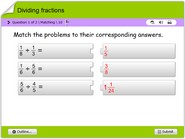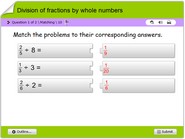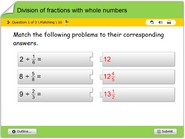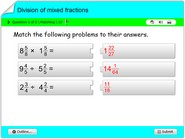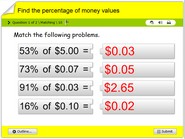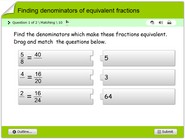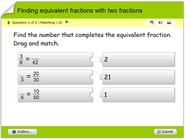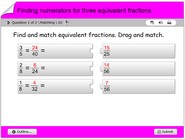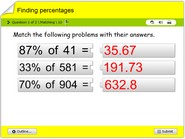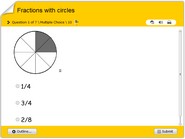Dividing fractions quiz
Test your skills with this dividing fractions quiz online.
Math test online on how to divide fractions
Review 3rd, 4th, 5th, 6th & 7th grade problems with this math test online on how to divide fractions. In this game children will improve their skills on understanding dividing fraction rules, solving multiple questions in the same area, developing mental math skills etc. This math quiz is also a good math game which could supplement math materials for parents and teachers of kids in primary school. Simple solve a problem, find its corresponding answer, drag and drop.
Dividing fractions is a bit more tricky than adding and subtracting them, but once you understand the concept, it’s not that hard.
First, let’s review what a fraction is. A fraction is a way of representing part of a whole. The top number in a fraction is called the numerator, and the bottom number is called the denominator. For example, in the fraction 3/4, 3 is the numerator and 4 is the denominator. The fraction 3/4 represents 3 out of 4 equal parts of something.
When we divide fractions, we are trying to find out how many of one fraction will fit into another. For example, if we have 4/5 of a pizza and we want to know how many slices 2/3 of a person will eat, we would divide the fraction of pizza by the fraction of the person. In math terms, this would be written as 4/5 ÷ 2/3.
To divide fractions, we need to do a little bit of flipping and multiplying. The first step is to flip the second fraction (the one being divided into). In our example, we would flip 2/3 to get 3/2.
Next, we will multiply the first fraction by the flipped second fraction. In our example, we would multiply 4/5 by 3/2, which would give us 12/10.
Now we need to simplify the fraction. We know that if we have 10/10 or 20/20, they are equivalent to one whole. So 12/10 is equivalent to 1 and 2/10.
So the final answer to 4/5 ÷ 2/3 is 12/10 = 1 and 2/10.
Another example, 2/3 divided by 4/5 would be (2/3) * (5/4) = 10/12 = 5/6
It is important to remember that dividing by a fraction is the same as multiplying by its reciprocal. The reciprocal of a fraction is found by flipping it. For example, the reciprocal of 4/5 is 5/4.
Dividing fractions may seem tricky at first, but with practice, it can become second nature. If you’re ever stuck, just remember to flip, multiply, and simplify!
In general, when dividing fractions, you invert the divisor (flip the second fraction) and then multiply the fractions, then simplify the result.
It’s also important to note that dividing fractions is not the same as multiplying them by a negative. Dividing by a negative fraction would be the same as multiplying by its reciprocal which is positive.
Also practice and understanding the rules of fractions and the numerator and denominator would be very helpful in solving dividing fraction problems.

